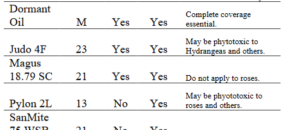This article has been adapted from an article written by Dr. Christelle Guédot, University of Wisconsin-Madison, and published in the Cranberry Crop Management Journal – Volume 35, Issue 1 Fanfare is a not a new insecticide, having been first registered with EPA (Environmental Protection Agency) in 1985, but it is new to the cranberry industry. […]
Continue reading...Tree Fruit IPM Report for April 27, 2022
Tree Fruit Phenology: Tree Fruit Phenology is about normal. In southern counties all peach orchards are nearing Shuck Split. Pears are at Petal Fall. Red Delicious is just past Full Bloom. Sweet cherries are at about nearing Petal Fall.
Continue reading...Anthracnose and Botrytis Control in Strawberries for 2022
Dr. Mengjun Hu, University of Maryland, and Kathy Demchak, Penn State University, have written an extensive article on effective strategies for Botrytis and Anthracnose fruit rot control for the 2022 season. Managing gray mold (Botrytis) on strawberries is increasingly challenging because of fungicide resistance development, plus a new Botrytis species that is less susceptible to […]
Continue reading...Scouting for Broad Mites in the Greenhouse

Broad mites (Polyphagotarsonemus latus) are an extremely small species of mites that affect many ornamental crops. At this point in the season they may be active in the greenhouse and should be included in all greenhouse IPM scouting programs. Broad mites are only 0.2 mm long, which is about half the size of a two-spotted […]
Continue reading...ATTENTION: Department of Agriculture Allows Controlled Open Burns to Protect Crops
With the state continuing to experience colder spring temperatures, the Department of Environmental Protection has agreed with NJDA Secretary Douglas Fisher’s request to allow farmers to do controlled open burning or use specialized torches known as smudge pots to protect flowering crops from damage beginning today, April 20, through Wednesday, May 4. Damage from freezing […]
Continue reading...Understanding Protectant Fungicides
(FRAC groups M01 – M12) in 2022
Protectant (contact) fungicides, such as the inorganics (copper, FRAC group M01) and sulfur (FRAC code M02); the dithiocarbamates (mancozeb, M03), phthalimides (Captan, M04), and chloronitriles (chlorothalonil, M05) are fungicides which have a low chance for fungicide resistance to develop. Protectant fungicides typically offer broad spectrum control for many different pathogens. Why wouldn’t fungi develop resistance […]
Continue reading...